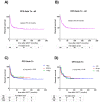Autologous Transplantation for Older Adults with AML
- PMID: 30235847
- PMCID: PMC6162649
- DOI: 10.3390/cancers10090340
Autologous Transplantation for Older Adults with AML
Abstract
While the majority of patients with acute myeloid leukemia (AML) are above the age of 65 years at diagnosis, the outcome of older AML patients remains disappointing. Even if standard intensive chemotherapy induces morphologic complete remission (CR1), relapses in older AML patients are common leading to poor long-term survival outcomes. Since autologous hematopoietic stem cell transplantation (HCT) offers distinct anti-leukemic effectiveness while avoiding graft-versus-host disease associated with allogeneic transplantation, it represents an option for consolidation treatment in selected older AML patients. However, prospective studies in older AML patients assessing the benefit of autologous HCT compared to chemotherapy consolidation or allogeneic transplantation are lacking. Consequently, clinicians face the dilemma that there is considerable ambiguity on the most appropriate consolidation treatment for older AML patients in CR1. This review highlights the possible role of autologous HCT for consolidation in older AML patients reaching CR1 after induction treatment.
Keywords: AML; autologous; elderly; older; outcome; review; survival; transplantation.
Conflict of interest statement
The authors declare no conflict of interest.
Figures

References
-
- Lowenberg B., Ossenkoppele G.J., van Putten W., Schouten H.C., Graux C., Ferrant A., Sonneveld P., Maertens J., Jongen-Lavrencic M., von Lilienfeld-Toal M., et al. High-dose daunorubicin in older patients with acute myeloid leukemia. N. Engl. J. Med. 2009;361:1235–1248. doi: 10.1056/NEJMoa0901409. - DOI - PubMed
-
- Vellenga E., van Putten W., Ossenkoppele G.J., Verdonck L.F., Theobald M., Cornelissen J.J., Huijgens P.C., Maertens J., Gratwohl A., Schaafsma R., et al. Autologous peripheral blood stem cell transplantation for acute myeloid leukemia. Blood. 2011;118:6037–6042. doi: 10.1182/blood-2011-07-370247. - DOI - PubMed
Publication types
Grants and funding
LinkOut - more resources
Full Text Sources
Other Literature Sources

